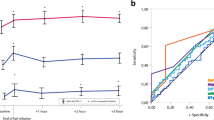Abstract
Objective
Characterize the normal human cardiovascular response to large volume infusion of normal saline.
Design:
Prospective, interventional trial.
Setting
ICU procedure room.
Participants
Healthy male volunteers (n=32).
Interventions
Volumetric echocardiography during 4-L saline infusion (3 L over 3 h followed by 1 L over 2 h).
Measurements and results
Following 3-L saline infusion, stroke volume and cardiac output increased approximately 10% without a significant change in heart rate or blood pressure. A decrease in end-systolic volume contributed to the increase in stroke volume to an extent similar to that provided by the increase in end-diastolic volume. All contractility indices except end-systolic wall stress/end-systolic volume index were increased at 3 h post-initiation of saline infusion. Stroke volume but not cardiac output remained elevated at 5 h with persistence of ventricular volume responses; only ejection fraction was significantly elevated among the contractility indices. Afterload measures including total peripheral resistance and end-systolic wall stress were significantly decreased after 3-L infusion but were unchanged compared to baseline following infusion of an additional 1 L over 2 h. Modeled blood viscosity studies demonstrate that changes in apparent contractility after 3-L saline infusion can be explained solely by viscosity reduction associated with hypervolemic hemodilution.
Conclusion
The initial increase in stroke volume associated with high volume saline infusion in normal volunteers is associated with increases of most load-dependent and ostensibly load-independent parameters of left ventricular contractility. This phenomenon is unlikely to represent a true increase in contractility and appears to be caused by reduced afterload as a consequence of decreased blood viscosity. This decrease in blood viscosity may complicate analysis of some previous in vivo studies examining the effect of volume loading on cardiac function using low-viscosity solutions.



Similar content being viewed by others
References
Patterson SW, Starling EH (1914) On the mechanical factors which determine the output of the ventricles. J Physiol 48:357–379
Stead EA, Warren JV (1947) Cardiac output in man: analysis of mechanisms of varying cardiac output based on recent clinical studies. Arch Intern Med 80:237
Kumar A, Anel R, Bunnell E, Zanotti S, Habet K, Haery C, Marshall S, Neumann A, Ali A, Kavinsky C, Parrillo JE (2004) Preload-independent mechanisms are partially responsible for improved cardiac output following large volume saline infusion in normal volunteers. Crit Care 8:R128–R136
Carabello BA, Spann JF (1984) The uses and limitations of end-systolic indices of left ventricular function. Circulation 69:1058–1064
Carabello BA (1989) Ratio of end-systolic wall stress to end-systolic volume: Is it a useful clinical tool? J Am Coll Cardiol 14:496–498
Gordon EP, Schnittger I, Fitzgerald PJ, Williams P, Popp RL (1983) Reproducibility of left ventricular volumes by two-dimensional echocardiography. J Am Coll Cardiol 2:506–513
Weber KT, Janicki JS, Reeves RC, Hefner LL (1976) Factors influencing left ventricular shortening in isolated canine heart. Am J Physiol 230:419–426
Nixon JV, Murray RG, Leonard PD, Mitchell JH, Blomqvist CG (1982) Effect of large variations in preload on left ventricular performance characteristics in normal subjects. Circulation 65:698–703
Holt JP (1957) Regulation of the degree of emptying of the left ventricle by the force of ventricular contraction. Circ Res 5:281–287
Mahler F, Ross JJr, O’Rourke RA, Covell JW (1975) Effects of changes of preload, afterload, and inotropic state on ejection and isovolumic phase measures of contractility in the conscious dog. Am J Cardiol 35:626–634
Quinones MA, Gaasch WH, Cole JS, Alexander JK (1975) Echocardiographic determination of left ventricular stress-velocity relations in man: with reference to the effects of loading and contactility. Circulation 51:689–700
Rankin LS, Moss S, Grossman W (1975) Alterations in preload and ejection phase indices of left ventricular performance. Circulation 51:910–915
Sagawa K (1981) The end-systolic pressure-volume relation of the ventricle: definition, modifications and clinical use. Circulation 63:1223–1227
Carabello BA, Nolan SP, McGuire LB (1981) Assessment of preoperative left ventricular function in patients with mitral regurgitation: value of the end-systolic wall stress-end-systolic volume ratio. Circulation 64:1212–1217
Marsh JD, Green LH, Wynne J, Cohn PF, Grossman W (1979) Left ventricular end-systolic pressure-dimension and stress-length relations in normal human subjects. Am J Cardiol 44:1311–1317
Daughters GT, Derby GC, Alderman EL, Schwarzkopf A, Mead CW, Ingels NB, Miller DC (1985) Independence of left ventricular pressure-volume ratio from preload in man early after coronary artery bypass graft surgery. Circulation 71:945–950
Prewitt RM, Wood LDH (1982) Effect of altered resistive load on left ventricular systolic mechanics in dogs. Anesthesiology 56:195–202
Calvin JE, Driedger AA, Sibbald WJ (1981) The hemodynamic effect of rapid fluid infusion in critically ill patients. Surgery 90:61–76
Daele ME van, Trouwborst AD, Woerkens LC van, et al (1994) Transesophageal echocardiography monitoring of preoperative acute hypervolemic hemodilution. Anesthesiology 81:602–609
Urzua J, Zurick AM, Starr NJ, Cosgrove DM, Yared JP, Estafanous FG (1985) Enhanced cardiac performance following cardiopulmonary bypass. J Cardiovasc Surg 26:53–58
Fowler NO, Holmes JC (1975) Blood viscosity and cardiac output in acute experimental anemia. J Appl Physiol 9:453–456
Mangano DT, Van Dyke DC, Ellis RJ (1980) The effect of increasing preload on ventricular output and ejection in man: limitations of the Frank-Starling mechanism. Circulation 62:535–541
Ohki S, Ishikawa S, Ohtaki A, Takahashi T, Koyano T, Otani Y, Murakami J, Mohara J, Isa Y, Kunimoto F, Morishita Y (1999) Hemodynamic effects of alpha-human atrial natriuretic polypeptide on patients undergoing open-heart surgery. J Cardiovasc Surg 40:781–785
Legault L, van Nguyen P, Holliwell DL, Leenen FH (1992) Hemodynamic and plasma atrial natriuretic factor responses to cardiac volume loading in young versus older normotensive humans. Can J Physiol Pharmacol 70:1549–1554
McDowell RJS (1924) A vago-pressor reflex. J Physiol 59:41–53
Oberg B, Thoren P (1972) Studies on left ventricular receptors; signalling in non-medullated vagal afferents. Acta Physiol Scand 85:145–163
Author information
Authors and Affiliations
Corresponding author
Additional information
An editorial regarding this article can be found in the same issue (http://dx.doi.org/10.1007/s00134-004-2318-1)
Electronic Supplementary Material
Rights and permissions
About this article
Cite this article
Kumar, A., Anel, R., Bunnell, E. et al. Effect of large volume infusion on left ventricular volumes, performance and contractility parameters in normal volunteers. Intensive Care Med 30, 1361–1369 (2004). https://doi.org/10.1007/s00134-004-2191-y
Received:
Accepted:
Published:
Issue Date:
DOI: https://doi.org/10.1007/s00134-004-2191-y




